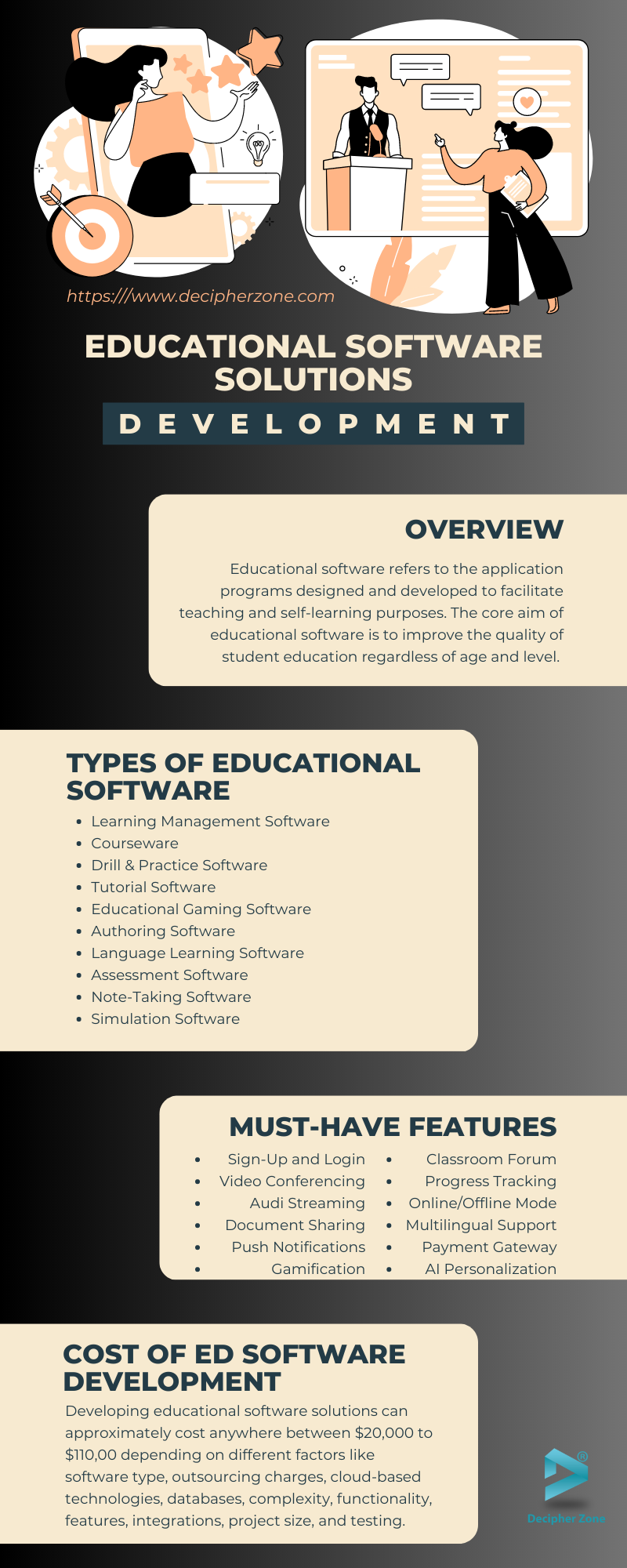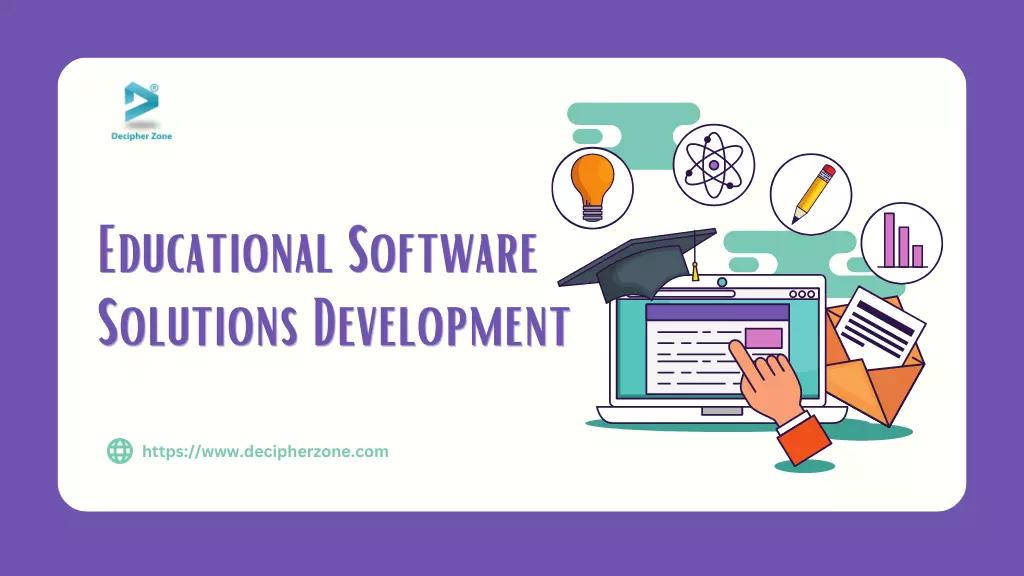Digitalization comes with ongoing revolutionary paradigm shifts that help businesses improve user experience, reduce operating costs, and minimize inefficiencies, regardless of the industry you are working in.
In light of this, there’s no doubt that the education industry is also catching up with the pace and transforming traditional classrooms into digital learning environments through leveraging technological advancements and e-learning solutions.
Read: Artificial Intelligence is Revolutionizing School Management Software
And, if you are an education provider who wants to enhance the learning experience for students by investing in educational software, then this blog is for you.
Today, we will discuss everything you need to know about educational technology to help you understand what to look for before hiring developers to create an educational solution.
An Overview of Educational Software Development
Educational software refers to the application programs designed and developed to facilitate teaching and self-learning purposes.
The core aim of educational software is to improve the quality of student education regardless of age and level. It allows students to learn new skills at their own pace and comfort area.
Educational software ranges from basic tutorial software to simulation software. The only thing a student needs to enroll in a course in these software applications is a computer or smartphone and a stable internet connection.
Read: What is Application Software
Benefits of educational software that both teachers and students can acquire are:
-
Organized material and structure of educational content with easier access.
-
Ease of communication and feedback between students and teachers.
-
Reduced educational costs
-
Easier tracking of progress and behavior of students
-
Reduced workloads for both teachers
-
Better student engagement
-
Personalized learning experiences
-
Automated assessments
Types of Educational Software Solutions
Now that we have a better understanding of educational software and its benefits, let’s move ahead with the types of educational software solutions that are available in the market and their purposes.
Read: What Role Do Physics Play in Modern Technologie
1. Learning Management Software
LMS is used to manage and organize content and resources for educational purposes. It is used by instructors or educators to create and provide courses, learning materials, or training programs and manage assignments, student progress as well as assessments.
2. Courseware
Courseware is derived from two words, i.e., course and software. As the name suggests, courseware refers to software that consists of instructions, instructional strategies, and educational content such as reference journals, materials, and research papers.
3. Drill and Practice Software
This software allows students to work on a given set of examples or problems to help them master a concept or skill and then receive performance feedback for further improvements.
4. Tutorial Software
It allows instructors to create interactive step-by-step guides, especially music production or programming, for users to follow along, understand the process, and learn skills.
5. Educational Games Software
This type of software focuses on game-based elements that motivate and keep the students engaged to learn new concepts in a fun-filled, interactive way.
6. Authoring Software
This software is designed for tutors or instructors that allows them to create and publish digital courses using text, graphics, videos, audio, and other multimedia files.
7. Language Learning Software
Whether you want to teach or learn a new language, this is the software you might be looking for. The language learning software lets instructors offer interactive lessons, pronunciation practices, vocabulary exercises, and progress assessments to the users that as a result makes their learning experience smoother.
8. Assessment Software
This software aims to help educators to design and manage tests and quizzes for analyzing the progress and learning of the students.
9. Note-Taking Software
This is software designed while keeping students' comfort in mind. Note-taking software enables students to store all notes and other critical information digitally in a cloud-based environment. These notes can be in the form of writing, recording, jotting, outlining, labeling, paraphrasing, and annotating.
10. Simulation Software
Students can explore complex systems and concepts through interactive simulations and virtual environments provided by this type of software. Science, engineering, and business are some of the subjects that are often taught using simulation software.

Must-Have Features in Educational Software
Next, comes the crucial question: What features should you include in educational software? To help you out, here is the list of must-have features you must consider while investing in education software development.
- Sign-up and Login: While the sign-up feature helps users to create their new account, login is used to open a session with an already existing account.
-
Video Conferencing: This feature allows users in different locations to hold remote meetings and collaborate to teach and learn by transforming video, audio, text, and presentation.
-
Audio Streaming: It helps in streaming audio files of lectures, instructions, and panel discussions on educational software to aid students’ analytical and critical thinking.
-
Document Sharing: This feature allows users to share project files, assignments, etc. over the software.
-
Push Notifications: It is used to avoid missing important lessons, tests, practices, or updates by sending push notifications on the user’s device.
-
Classroom Forum: It is a communication tool embedded in educational software that allows students to communicate with instructors, content, or one another.
-
Progress/Performance Tracking Dashboard: With this feature, both students and teachers can keep track of their progress and performance throughout the course.
-
Online and Offline Mode: This feature allows students to stream the classes online or download them for future reference.
-
Multilingual Support: While some users are comfortable with a certain language others are not, so multilingual support will help them in translating the content of the page and understand it more effectively.
-
Payment Gateway: For paid courses, having a secured payment feature is a boon. It will make it easier for users to pay for the courses and get access to the content in real time.
-
AI Personalization: Based on the courses or subjects that a student is interested in, the artificial intelligence personalization feature will recommend more related topics that they can cover.
-
Gamification: It involves implementing game-like elements such as leaderboards, badges, challenges, or points into the software to increase the student’s engagement with educational content.
Tech-Stack To Consider While Developing Educational Software
Once you decide the features you want to add and the type of software that is the most ideal for your business, it is time to determine the ideal tech stack to incorporate into your educational software.
Read: Top 10 Web App Development Ideas
Although there is a vast amount of technologies to consider and choose from, below are the fundamental ones without which developing any software is impossible.
Front-End Development
It refers to the development of the interface to help users view and interact with the application. The primary concern behind front-end development is the creation of convenient, accessible, and clear user interfaces.
The basic tech stack for developing the front-end includes HTML, CSS, and JavaScript along with their frameworks and libraries that make the work easier.
Back-End Development
It describes the logical side of the application that ensures smooth processing of the user’s request, focusing on APIs, architecture, databases, servers, etc. Simply put, the back-end involves working with everything that a user can’t see.
To create the back-end of the educational software, some of the tech-stack you need to consider are programming languages (Java, PHP, or Python), Databases (MongoDB, PostgreSQL, or MySQL), Frameworks (Spring, Django, or Node.js)m and Servers (Apache Tomcat, Apache Nginx, AWS Elastic Load Balancing, or HAProxy).
Educational Software Solutions Development Cost
Software development cost varies depending on different factors like software type, outsourcing charges, cloud-based technologies, databases, complexity, functionality, features, integrations, project size, and testing.
Read: E-Learning Web App Development Cost
Although we cannot give you an exact cost, developing educational software solutions can approximately cost anywhere between $20,000 to $110,00.
Why Choose Us as Your Outsourcing Partner?
There is not just one but multiple reasons why Decipher Zone can be an ideal outsourcing partner to make your vision a reality.
Here we have enlisted a few benefits you can obtain by hiring developers from us.
Agile Development Approach
Our team implements an agile development methodology where we split the project into multiple sprints/phases for better flexibility, continuous improvements, reduced risks, better control, and high end-product quality.
Experienced Developers
We have an experienced team of developers with years of expertise in developing scalable and efficient educational software to help you reach your target audience and improve ROI.
Competitive Rates
Despite being highly experienced, we take care of your pockets by offering competitive pricing without compromising on the quality of the software solutions.
Custom Solutions
While keeping your unique requirements in mind, we build and deliver customized solutions to meet your business goals.
Transparent Work Approach
With the regular medium of communication such as Slack, email, phone, and Skype we keep you in the loop of the system development life cycle.
FAQs About Educational Software Solutions Development
What is education software?
It is a term used to describe software applications made for teachers to create educational content, manage classrooms, and share lessons to help students learn from anywhere in the world at any time.
What does education software do?
Educational software implements study material in an easy-to-understand multimedia format with a higher interactivity interface to make learning faster and more efficient.
What are the types of educational software?
Learning Management, Courseware, Drill and Practice, Tutorial, Educational Games, Authoring, Language Learning, Assessment, Note Taking, and Simulation software are 10 major types of educational software.

